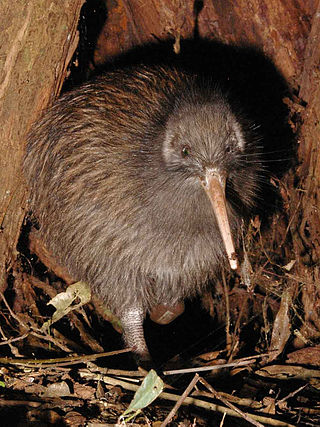
Kiwi are flightless birds endemic to New Zealand of the order Apterygiformes. The five extant species fall into the family Apterygidae and genus Apteryx. Approximately the size of a domestic chicken, kiwi are the smallest ratites.

Toxoplasmosis is a parasitic disease caused by Toxoplasma gondii, an apicomplexan. Infections with toxoplasmosis are associated with a variety of neuropsychiatric and behavioral conditions. Occasionally, people may have a few weeks or months of mild, flu-like illness such as muscle aches and tender lymph nodes. In a small number of people, eye problems may develop. In those with a weak immune system, severe symptoms such as seizures and poor coordination may occur. If a person becomes infected during pregnancy, a condition known as congenital toxoplasmosis may affect the child.
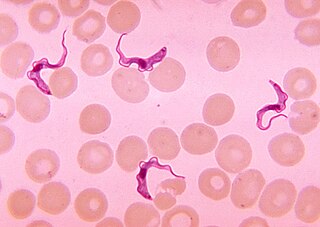
Trypanosoma is a genus of kinetoplastids, a monophyletic group of unicellular parasitic flagellate protozoa. Trypanosoma is part of the phylum Sarcomastigophora. The name is derived from the Greek trypano- (borer) and soma (body) because of their corkscrew-like motion. Most trypanosomes are heteroxenous and most are transmitted via a vector. The majority of species are transmitted by blood-feeding invertebrates, but there are different mechanisms among the varying species. Some, such as Trypanosoma equiperdum, are spread by direct contact. In an invertebrate host they are generally found in the intestine, but normally occupy the bloodstream or an intracellular environment in the vertebrate host.

The North Island brown kiwi is a species of kiwi that is widespread in the northern two-thirds of the North Island of New Zealand and, with about 35,000 remaining, it is the most common kiwi. It holds the world record for laying the largest eggs relative to its body size.
Besnoitia besnoiti is an apicomplexan protozoan parasite, closely related to Toxoplasma gondii and Neospora caninum,. It is part of a larger genus Besnoiti affecting multiple animal species, but Besnoita besnoiti, can affect livestock. and more specifically cattle as intermediate host, although some specific antibodies have been found in roe deer and red deer.

The brown four-eyed opossum is a pouchless marsupial of the family Didelphidae. It is found in different forested habitats of Central and South America, from Nicaragua to Brazil and northern Argentina, including southeastern Colombia, Paraguay and eastern Peru and Bolivia, at elevations from sea level to 1,500 m (4,900 ft). It is the only recognized species in the genus Metachirus, but molecular phylogenetics studies suggest that it should probably be split into several species. Population densities are usually low, and it is uncommon in parts of Central America. A density of 25.6/km2 (66/sq mi) was reported near Manaus, Brazil. Its karyotype has 2n = 14 and FN = 24.
Uncinaria stenocephala is a nematode that parasitizes dogs, cats, and foxes as well as humans. It is rare to find in cats in the United States. Uncinaria stenocephala is the most common canine hookworm in cooler regions, such as Canada and the northern regions of the US, where it can be found primarily in foxes (40%). U. stenocephala is also one of the most common hookworms in the UK, called the northern hookworm, however it has a rather low prevalence. U. stenocephala is also considered to be zoonotic hookworms because they live in animals but can be transmitted to humans.

Haematopinus is a genus of insects in the superfamily Anoplura, the sucking lice. It is the only genus in the family Haematopinidae, known commonly as the ungulate lice. All known species are of importance in veterinary medicine. These lice are some of the most economically important ectoparasites of domestic animals. Species infest many domesticated and wild large mammals, including cattle, horses, donkeys, swine, water buffalo, African buffalo, antelope, zebra, deer, and camels. The species Haematopinus tuberculatus has great importance in the water buffalo breading, since this louse is specific to buffaloes, being the main ectoparasite of the species, with important sanitary and economic burden. The Haematopinus tuberculatus is suspected to be involved in the transmission of diseases, such as anaplasmosis. The parasites are found infesting buffaloes in greater concentrations around the ears, base of horns, side of the neck, around the scrotum or udder, and especially at the tip of the tail.

The pinworm, also known as threadworm or seatworm, is a parasitic worm. It is a nematode (roundworm) and a common intestinal parasite or helminth, especially in humans. The medical condition associated with pinworm infestation is known as pinworm infection (enterobiasis) or less precisely as oxyuriasis in reference to the family Oxyuridae.
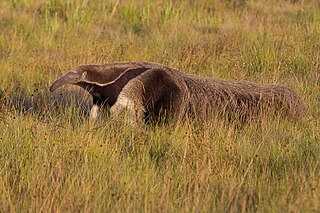
Anteaters are the four extant mammal species in the suborder Vermilingua, commonly known for eating ants and termites. The individual species have other names in English and other languages. Together with the sloths, they are within the order Pilosa. The name "anteater" is also commonly applied to the unrelated aardvark, numbat, echidnas, and pangolins, although they are not closely related to them.

Thelaziasis is the term for infestation with parasitic nematodes of the genus Thelazia. The adults of all Thelazia species discovered so far inhabit the eyes and associated tissues of various mammal and bird hosts, including humans. Thelazia nematodes are often referred to as "eyeworms".
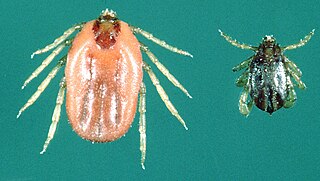
The Asian blue tick is an economically important tick that parasitises a variety of livestock species especially cattle, on which it is the most economically significant ectoparasite in the world. It is known as the Australian cattle tick, southern cattle tick, Cuban tick, Madagascar blue tick, and Puerto Rican Texas fever tick.

Porocephalus crotali is a parasitic crustacean from the group Pentastomida, also known as tongue worms.
Amphistomiasis is a parasitic disease of livestock animals, more commonly of cattle and sheep, and humans caused by immature helminthic flatworms belonging to the order Echinostomida. The term amphistomiasis is used for broader connotation implying the disease inflicted by members of Echinostomida including the family Paramphistomidae/Gastrodiscidae ; whereas paramphistomiasis is restricted to that of the members of the family Paramphistomatidae only. G. discoides and Watsonius watsoni are responsible for the disease in humans, while most paramphistomes are responsible in livestock animals, and some wild mammals. In livestock industry the disease causes heavy economic backlashes due to poor production of milk, meat and wool.
Fading puppy syndrome is when a puppy dies within the first few weeks of life without a clear cause of death or clinical signs, that is to say, they fail to thrive. Death usually occurs within the first five days of life, but can happen up to ten weeks of age. It is responsible for about 50% of deaths of new-born puppies.

Mary Morgan-Richards is a New Zealand biologist, and as of 2019 is a full professor at Massey University.
Wendy Irene Baltzer is an American veterinarian, small animal surgeon and academic.
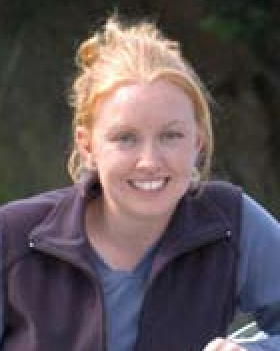
Karen Ann Stockin is a New Zealand academic marine ecologist, and as of 2021 is a full professor at Massey University. Her research focuses on animal welfare and the impacts of human activities on cetacean populations, including tourism effects, and persistent marine contaminants.

Isabel Castro is professor of wildlife biology at Massey University in New Zealand. Her research focuses on conservation biology, primarily of birds and native ecosystems, but also including invertebrates and introduced mammals. She is a principal investigator in the Te Pūnaha Matatini Centre of Research Excellence.
Ophidascaris robertsi is a nematode usually parasitic in the carpet python. It is found in Australia and Papua New Guinea. Pythons serve as the typical hosts for Ophidascaris robertsi, which has an indirect life cycle. The adult parasites develop nodular masses in the oesophagus and stomach of carpet pythons and place a small piece of their anterior bodies into the nodules that protrude from the digestive mucosa. When endemic parasites like Ophidascaris robertsi infect local fauna, the pathological changes that follow are frequently self-limiting or do not result in illness.













